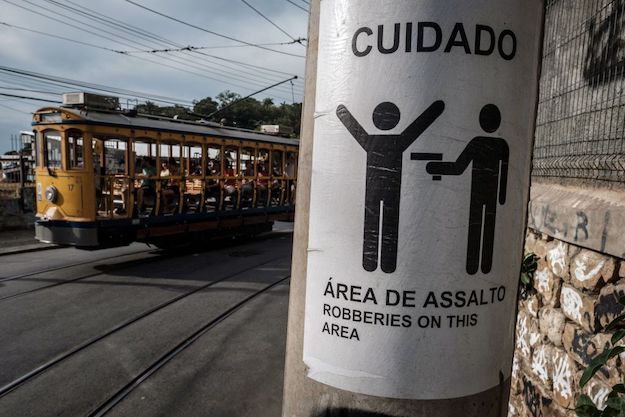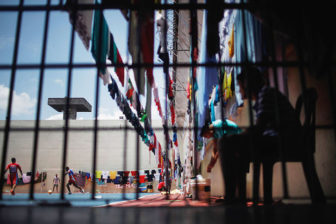Brazilians have an uneasy but enduring co-existence with homicide. Over 1,060,000 of them have been murdered since 2000.
Despite that, attempts to adopt a comprehensive national strategy to reduce the murder rate have sputtered. As the Brazilian government struggles to launch a new federal agenda to fight crime and corruption, it would do well to consider subnational efforts to tackle the problem.
Not all the violent crime reductions strategies that have sprung up in states like Espírito Santo, Minas Gerais or Rio de Janeiro have been successful. But collectively, they offer hints into what works and what doesn’t – and even how some effective measures could be applied on a larger scale.
The state of São Paulo, for example, has registered sharp reductions in murder in recent years. Between 2001 and 2018 the state homicide rate plummeted from 33.1 per 100,000 to 6.4 per 100,000. Metropolitan São Paulo’s homicide rate saw an even more dramatic fall, from 49.2 per 100,000 in 2001 to just 5.5 per 100,000, making it one of the safest large cities in Brazil.
These reductions did not happen spontaneously. They coincided with a determined focus on reducing homicides across the state. Strategies included police reform to improve data collection, real-time crime mapping, police training, and coordination between the civil and military police forces. Other priorities included mitigating secondary factors that influence violence, such as limiting late-night licenses for alcohol sales.
Other structural factors also likely played a role in São Paulo’s violent crime drop. Researchers have pointed to the state’s declining youth population and falling unemployment as potentially important variables, as well as the “pax mafiosa” exerted by the most powerful drug trafficking faction in Brazil, the Primeiro Comando da Capital (PCC).
Another example from São Paulo provides a still clearer indication of how an intervention introduced by public authorities can influence homicide rates. In 2000, a new local security plan was implemented in the municipality of Diadema. The initiative was innovative for its time, involving better collaboration between municipal authorities (including the civil guard), military police and local communities, a series of educational programs, youth-based activities, and firearm and alcohol controls.
After an analysis of crime data showed how most violent incidents occurred in the early morning hours and in close proximity to bars (typically associated with alcohol-inflamed brawls and disputes), municipal authorities introduced new laws to regulate alcohol sales in bars after 11pm, monitored alcohol vendors, installed public lighting and security cameras, and introduced changes in public safety management procedures.
By 2002, the homicide rate in Diadema had declined by 44% and assaults against women had dropped by 56%. The initiative was received with a high level of public support. However, like other programs that are prematurely determined to be successful, it started running out of steam and some residents questioned what they saw as excessive restrictions on recreation and commerce. Also, people learned how to circumvent the rules for alcohol sales with the emergence of street parties (bringing new crime problems) that could not be influenced by the new regulations.
The state of Pernambuco has also suffered from periodic spasms of homicidal violence. Authorities there introduced the Pacto Pelo Vida program in 2007 with the explicit goal of reducing lethal violence, strengthening police performance, bolstering prevention measures and cultivating norms for respecting human rights. Importantly, Pacto Pela Vida was endorsed by a widely respected governor of Pernambuco, the late Eduardo Campos, who served as a steadfast champion of the initiative.
The initial results of the Pernambuco program were impressive. Between 2007 and 2015 homicides dropped by 33%. Then, unexpectedly Campos died and the program began to lose its way. By 2017, homicides shot-up to their highest levels in 14 years, increasing by 58% from 2015. By the end of 2018, homicides had fallen again, though these decreases were concentrated in a few cities and mainly associated with reductions in killings between rival criminal groups.
The Paraiba Peace Program, created in 2011, focused on citizen-led approaches to public security. The intervention included a new data-driven crime mapping system (Núcleo de Análise Criminal e Estatística – NACE) in order to monitor key metrics of security in designated areas, including homicide. One goal was to ensure that both military and civil police shared responsibility for reducing crime, and had an incentive to collaborate to achieve sustainable reductions. This involved setting-up a “reward system” to compensate police units that met specific targets. The program appears to have generated positive results: Paraiba has experienced a steady decline in homicide over the past eight years, falling by 18% between 2015 and 2018.
Finally, two more examples from Rio de Janeiro have been credited with reducing violence between 2009-2015. The first was a “system of targets” approach that encouraged cooperation between the military and civil police, in some cases for the first time. The second example was the controversial pacification police units (UPP) program that mobilized “proximity policing” in lower-income areas of metropolitan Rio de Janeiro. To implement its UPP program, the state’s military police enlisted 9,000 newly recruited officers, deploying them to 38 areas reaching over 1.5 million people.
Between 2009-2015 homicide rates dropped by 66% in Rio de Janeiro, but have since increased year on year. In 2016, the state of Rio de Janeiro faced a crippling economic crisis, political scandal and collapsing leadership. This affected the system of targets that resulted in the end of the payments in 2016, (the system was re-instated in 2019).
The UPP program faced severe criticism for failing to address systemic social and economic challenges in affected communities, and effectively ground to a halt in 2018. The intervention also lost credibility owing to highly publicized abuses committed by UPP officers themselves. By the end of 2018 homicides in Rio de Janeiro had climbed back up to pre-2009 levels (though are down again in early 2019), including increases in areas that had previously been UPP sites.
Learning lessons
Several lessons stand out from these and other homicide-reduction programs such as Fica Vivo in Belo Horizonte and Estado Presente in Espírito Santo.
Broadly, the homicide reduction strategies that had the biggest impact were guided by unambiguous priorities and restricted their activities to those with a demonstrated track-record of success. Violence reduction plans with clear targets and performance indicators, effective data harvesting systems to track trends, investment in in-house monitoring and analytical capacities to interpret results, routine supervision, ongoing training and professional development, and constant evaluation all stand out.
In Brazil, the most effective homicide reduction interventions also had a strong personal dimension. A necessary ingredient of success was the presence of strong leaders, including both governors and mayors, who could captain efforts and lead from the front. Also important were engaged business people, academic specialists and civil society groups who could serve as a brain trust and drive the process forward.
Effective homicide reduction also required the adoption of comprehensive approaches, combining specific adaptations in policing practice with prevention measures targeted to at-risk places and people. This demands the creation of partnerships across institutional silos – between state and city authorities, but also across different government agencies. Central to success are strong partnerships with universities and think tanks that can help identify evidence-based pathways for improvement.
Notwithstanding serious crime challenges and excessive police violence, some Brazilian states and municipalities have made progress in preventing and reducing murder. In all cases, successful interventions took time to have a lasting effect. This is a challenge given electoral cycles and economic volatility. But when interventions were terminated prematurely – either because of a change of leadership or a lack of funds – the homicide reducing effects vanished.
While there are many international examples of successful murder reduction measures – and frequent visits from Americans with glossy proposals for what works – Brazilians would do well to also take a closer look at home-grown efforts. They have much to learn from the programs that have worked well, as well as from those that have not.
—
Muggah is the co-founder of the Igarapé Institute and the SecDev Group and Foundation. Chainey is an associate professor of security and crime science, UCL and an Igarapé fellow. Giannini is researchers at the Igarapé Institute.






